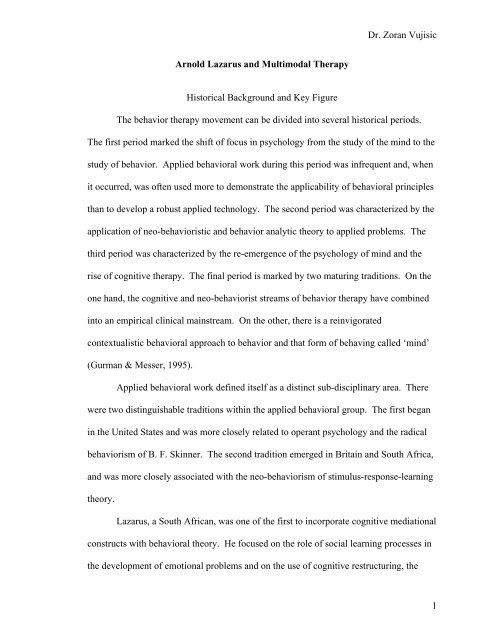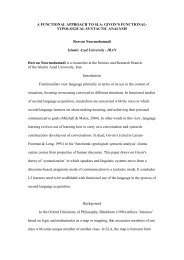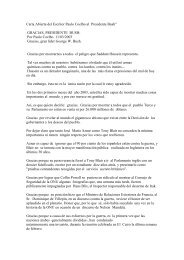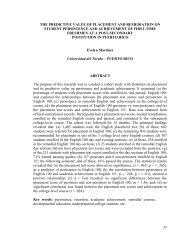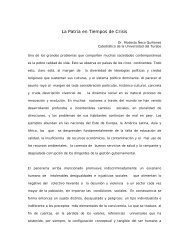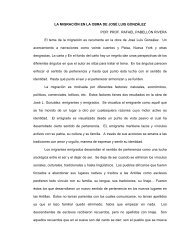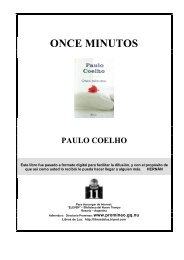Dr. Zoran Vujisic Arnold Lazarus and Multimodal Therapy Historical ...
Dr. Zoran Vujisic Arnold Lazarus and Multimodal Therapy Historical ...
Dr. Zoran Vujisic Arnold Lazarus and Multimodal Therapy Historical ...
You also want an ePaper? Increase the reach of your titles
YUMPU automatically turns print PDFs into web optimized ePapers that Google loves.
<strong>Arnold</strong> <strong>Lazarus</strong> <strong>and</strong> <strong>Multimodal</strong> <strong>Therapy</strong><br />
<strong>Historical</strong> Background <strong>and</strong> Key Figure<br />
<strong>Dr</strong>. <strong>Zoran</strong> <strong>Vujisic</strong><br />
The behavior therapy movement can be divided into several historical periods.<br />
The first period marked the shift of focus in psychology from the study of the mind to the<br />
study of behavior. Applied behavioral work during this period was infrequent <strong>and</strong>, when<br />
it occurred, was often used more to demonstrate the applicability of behavioral principles<br />
than to develop a robust applied technology. The second period was characterized by the<br />
application of neo-behavioristic <strong>and</strong> behavior analytic theory to applied problems. The<br />
third period was characterized by the re-emergence of the psychology of mind <strong>and</strong> the<br />
rise of cognitive therapy. The final period is marked by two maturing traditions. On the<br />
one h<strong>and</strong>, the cognitive <strong>and</strong> neo-behaviorist streams of behavior therapy have combined<br />
into an empirical clinical mainstream. On the other, there is a reinvigorated<br />
contextualistic behavioral approach to behavior <strong>and</strong> that form of behaving called ‘mind’<br />
(Gurman & Messer, 1995).<br />
Applied behavioral work defined itself as a distinct sub-disciplinary area. There<br />
were two distinguishable traditions within the applied behavioral group. The first began<br />
in the United States <strong>and</strong> was more closely related to operant psychology <strong>and</strong> the radical<br />
behaviorism of B. F. Skinner. The second tradition emerged in Britain <strong>and</strong> South Africa,<br />
<strong>and</strong> was more closely associated with the neo-behaviorism of stimulus-response-learning<br />
theory.<br />
<strong>Lazarus</strong>, a South African, was one of the first to incorporate cognitive mediational<br />
constructs with behavioral theory. He focused on the role of social learning processes in<br />
the development of emotional problems <strong>and</strong> on the use of cognitive restructuring, the<br />
1
<strong>Dr</strong>. <strong>Zoran</strong> <strong>Vujisic</strong><br />
development of social-problem-solving capacities, <strong>and</strong> the acquisition of behavioral skills<br />
in solving them.<br />
<strong>Lazarus</strong> belongs to a group of pragmatic eclectics, <strong>and</strong> applies the term ‘technical<br />
eclecticism’ to his approach. Technical eclecticism holds that theoretical integration<br />
involves fusing theories that are irreconcilable, <strong>and</strong> that techniques should be combined<br />
pragmatically on the basis of observed or presumed clinical efficacy. <strong>Lazarus</strong>’<br />
multimodal therapy is a good example of this approach. Techniques from Gestalt,<br />
cognitive, behavioral, psychodynamic, <strong>and</strong> family systems therapy all may be applied in<br />
one individual’s therapy.<br />
<strong>Multimodal</strong> therapy centers on the commitment to operate not out of theoretical<br />
preference, but out of what seems best for the client. Specifically, it means to use the<br />
methods that comparative outcome research has shown to work best with the problems<br />
manifested by the clients. This position seems to make sense, especially since no<br />
traditional theories of change have succeeded in convincing the professional public of<br />
deserving singular precedence; consequently, practitioners <strong>and</strong> researchers are exploring<br />
ways of synthesizing diverse elements into flexible multifaceted orientations.<br />
<strong>Lazarus</strong>’ therapy is one of the varieties of behavior-shaping approaches. His<br />
MMT (Multi Modal <strong>Therapy</strong>) is a technically eclectic approach. Among other eclectic<br />
approaches in recent years, this is a more traditional approach that searches the literature<br />
for specific techniques that are most effective for specific types of clients with specific<br />
types of problems. The foundation of this approach is actuarial rather than theoretical,<br />
applying what the research literature predicts will work best under specific conditions.<br />
Technical eclectics use techniques drawn from different sources without necessarily<br />
2
<strong>Dr</strong>. <strong>Zoran</strong> <strong>Vujisic</strong><br />
accepting the theories that generated the procedures even if the assumptions underlying<br />
the therapies conflict. <strong>Lazarus</strong>’ MMT applies the most promising techniques across a<br />
range of modalities: behavior, affect, sensation, imagery, cognition, interpersonal<br />
relationships, <strong>and</strong> drugs (captured by the acronym, BASIC I.D.).<br />
The BASIC ID formula provides a systematic <strong>and</strong> thorough method of assessment<br />
<strong>and</strong> offers an eclectic treatment approach. With such a treatment approach, the client will<br />
develop more coping responses <strong>and</strong> will be less likely to succumb to past behavior<br />
patterns.<br />
<strong>Multimodal</strong> therapy is not so much a ‘school’ of therapy as a way of organizing<br />
information obtained from the client <strong>and</strong> then selecting treatments in terms of the seven<br />
interactive modalities of human personality expressed in the acronym BASIC I.D.<br />
<strong>Multimodal</strong> therapy is a comprehensive treatment approach <strong>and</strong> may be viewed as<br />
an extension of Broad-Spectrum Behavior <strong>Therapy</strong>. Broad-Spectrum Behavior <strong>Therapy</strong><br />
is founded on basic learning theory <strong>and</strong> exp<strong>and</strong>s into the area of private events, covert<br />
processes, <strong>and</strong> cognitions. While exposing this theory to further refinement, <strong>Lazarus</strong><br />
developed an applied conceptualization of this model. Although multimodal therapy uses<br />
many techniques from behavior modification, it also incorporates elements of social<br />
learning theory, general systems theory, <strong>and</strong> group communications theory.<br />
<strong>Multimodal</strong> therapy recognizes the following areas as viable avenues for<br />
treatment: a) learning theory operant <strong>and</strong> classical conditioning; b) modeling <strong>and</strong><br />
vicarious processes; c) private events-cognitive theory; d) non-conscious processes (not<br />
to be confused with the unconscious) that address levels of awareness or conscious<br />
comprehension; <strong>and</strong> e) defensive reactions.<br />
3
<strong>Dr</strong>. <strong>Zoran</strong> <strong>Vujisic</strong><br />
The multimodal approach rests on the assumption that unless the seven discrete<br />
but interactive modalities are assessed, treatment is likely to overlook significant<br />
concerns. Initial interviews provide an initial overview of a client’s significant<br />
Behaviors, Affective responses, Sensory reactions, Images, Cognitions, Interpersonal<br />
relationships, <strong>and</strong> the need for <strong>Dr</strong>ugs <strong>and</strong> other biological interventions. These<br />
modalities exist in a state of reciprocal transaction <strong>and</strong> flux, connected by complex chains<br />
of behavior <strong>and</strong> other psycho-physiological processes.<br />
This framework is used to categorize the client’s problems, plan the therapist’s<br />
intervention, <strong>and</strong> chart the client’s progress. The first six modalities refer to: human<br />
behavior; emotional responses; sensory experiences (sight, hearing, smell, touch or taste);<br />
conjured up images; thought; interaction with others. The seventh modality refers to the<br />
fact that we are biological organisms subject to biochemical influences from food <strong>and</strong><br />
drugs.<br />
The framework is usually introduced to the client in the first therapy session. It<br />
allows the therapist <strong>and</strong> the client to draw up an organized list of the client’s problems<br />
<strong>and</strong> to plan appropriate treatments for each problem. A framework has the extra benefit<br />
of helping the therapist to check that every potential problem area has been covered in<br />
assessing the client.<br />
During the treatment, more detailed assessments may be carried out using<br />
questionnaires. The client’s strengths in the modalities can be represented as a bar chart,<br />
known as the structural profile. The actual profile can be compared with the client’s<br />
desired profile - the way he or she would like to be - in order to plan <strong>and</strong> monitor<br />
treatment.<br />
4
<strong>Dr</strong>. <strong>Zoran</strong> <strong>Vujisic</strong><br />
In planning treatment, multimodal therapists draw freely from other schools.<br />
They may advise a client to use techniques they themselves do not practice <strong>and</strong> to do<br />
home exercises or reading.<br />
For example, they may use commercially produced relaxation tapes to teach the<br />
client to relax. They might even, in consultation with the client, choose treatments from<br />
outside what we normally think of as psychotherapy. This might involve diet <strong>and</strong><br />
exercise when an unhealthy lifestyle might be part of the overall pattern of problems<br />
experienced by a client suffering from stress at work.<br />
<strong>Multimodal</strong> therapists take pains to tailor their approach to each client. They<br />
adapt their manner, their dress <strong>and</strong> even their style of interaction to the needs of the<br />
client.<br />
<strong>Multimodal</strong> therapy is intended to be quick <strong>and</strong> flexible. Sessions can be as short<br />
as 20 minutes or can last several hours, depending on clients’ needs. Progress is<br />
reviewed frequently <strong>and</strong> a typical course of treatment would take six sessions with the<br />
gaps between sessions increasing as the client improves.<br />
<strong>Lazarus</strong> believed that changing one’s behavior could lead to important insights,<br />
but he was skeptical that this worked in reverse. As a result, he formulated BASIC I.D.,<br />
as a tool for therapists to assess clients. The first letter of the acronym “B” represents the<br />
behaviors clients want to increase or decrease. “A” st<strong>and</strong>s for affect or emotions, <strong>and</strong> is<br />
used to explore clients’ relationships with anger, joy, <strong>and</strong> anxiety. “S” refers to<br />
sensations; having clients identify physical sensations helps them get a better sense of<br />
where in their bodies emotions are physically felt. “I” st<strong>and</strong>s for imagery. This was<br />
separated from cognition because people who engage in positive self-talk can still hold<br />
5
<strong>Dr</strong>. <strong>Zoran</strong> <strong>Vujisic</strong><br />
negative mental pictures of themselves that may impede their therapeutic progress.<br />
<strong>Lazarus</strong> believed that helping clients develop positive mental pictures enables them to<br />
increase desired behaviors <strong>and</strong> to have more effective interpersonal interactions. “C”<br />
refers to the cognitive functioning of clients <strong>and</strong> their ability to recognize self-talk,<br />
determining the extent to which they participate in irrational self-talk. The second “I”<br />
represents interpersonal relations, <strong>and</strong> its purpose is to identify skill deficiencies or<br />
unrealistic expectations from others. Finally, “D” represents drugs <strong>and</strong> biology. This<br />
also is used to indicate how clients view nutrition, exercise, <strong>and</strong> alcohol or illegal drug<br />
use.<br />
Once the interview <strong>and</strong> questionnaire are completed, the information is evaluated<br />
<strong>and</strong> a treatment plan is designed with special attention paid to the client’s BASIC I.D.<br />
‘firing order’. <strong>Lazarus</strong> described the firing order as the sequence to which the client<br />
responds to certain events. In addition to helping the therapist identify a treatment plan,<br />
explaining firing order to clients can prove to be therapeutic by allowing the clients to see<br />
the antecedents to their problems.<br />
The therapist, usually in concert with the client, determines which specific<br />
problems across the BASIC I.D. are most salient. Whenever possible, the choice of<br />
appropriate techniques rests on well-documented research data, but multimodal therapists<br />
remain essentially flexible <strong>and</strong> are willing to improvise when necessary. They are<br />
technically eclectic, but remain theoretically consistent, drawing mainly from a broad-<br />
based social <strong>and</strong> cognitive learning theory (because its tenets are open to verification or<br />
disproof). <strong>Multimodal</strong> therapy contends that many problems arise from misinformation<br />
<strong>and</strong> missing information. Therefore, with most outpatients, bibliotherapy, the use of<br />
6
selected books for home reading, often provides a springboard for enhancing the<br />
treatment process <strong>and</strong> content (Corsini & Wedding, 2000).<br />
An assiduous attempt is made to tailor the therapy to each client’s unique<br />
<strong>Dr</strong>. <strong>Zoran</strong> <strong>Vujisic</strong><br />
requirements. Therefore, in addition to mastering a wide range of effective techniques,<br />
multimodal clinicians address the fact that different relationship styles are also necessary.<br />
Because the therapeutic relationship is the soil that enables the techniques to take root, it<br />
is held that the correct method delivered within <strong>and</strong> geared to the context of the client’s<br />
interpersonal expectancies, will augment treatment adherence <strong>and</strong> enhance therapeutic<br />
outcomes. Another issue that requires careful scrutiny is whether individual therapy,<br />
couples therapy, family therapy, or participation in a group (or some combination of the<br />
foregoing) seems advisable. Referrals are effected when necessary <strong>and</strong> feasible.<br />
Determining the length or amount of data collection depends on both the goals<br />
<strong>and</strong> the setting of the client. Essentially, data should be collected for long enough to<br />
establish a baseline. The length of the baseline is dependent on the behavior. Reliable<br />
baseline data depends on two factors: a) the counselor’s ability to make accurate<br />
observations of the behaviors, <strong>and</strong> b) the client’s ability to self-monitor the target<br />
behaviors. The client also must be able to identify the operationally defined behavior, as<br />
well as be motivated to collect the personal data. The counselor must be able to detect<br />
when this is not the case with the client <strong>and</strong> when the client is providing inaccurate data.<br />
This most often occurs when a client wants to be perceived favorably by the counselor.<br />
Data should always be collected throughout the treatment process <strong>and</strong> analyzed for<br />
trends. This recommendation enables the counselor to quickly make changes in<br />
treatment <strong>and</strong> ensures client success in the shortest amount of time.<br />
7
Evaluation<br />
<strong>Dr</strong>. <strong>Zoran</strong> <strong>Vujisic</strong><br />
The efficacy of MMT has been well documented. <strong>Lazarus</strong> found that using MMT<br />
with people who had no success with therapy in the past proved to have significant<br />
beneficial results. The efficacy of MMT is clear, <strong>and</strong> multidimensional rationale has<br />
broadened our underst<strong>and</strong>ing of holistic helping.<br />
One of the problems with this form of eclecticism is that it often proceeds as if a<br />
therapeutic technique is a disembodied procedure that can be readily transported from<br />
one context to another, much like a medical technique, without consideration of its new<br />
psychotherapeutic context. Therefore a therapeutic procedure such as an interpretation<br />
or empathic response does not st<strong>and</strong> on its own, independent of the framework of<br />
meaning created by the entire therapeutic system.<br />
This part-whole interdependence can be illustrated in various ways. For example,<br />
a client whose treatment has been primarily cognitive-behavioral may experience a<br />
therapist’s shift to empathic/reflective responding as a withholding of needed<br />
psychological expertise. Conversely, a client whose treatment has been client-centered or<br />
psychoanalytic may experience a shift to cognitive-behavioral interventions as<br />
controlling. Although such interventions have the potential to be effective, their meaning<br />
<strong>and</strong> impact should be explored in their new context.<br />
Wachtel <strong>and</strong> Messer (1998), state that despite <strong>Lazarus</strong>’ de-emphasis on theory, he<br />
acknowledged that every practitioner uses at least some theory to guide the choices.<br />
<strong>Multimodal</strong> therapy, <strong>Lazarus</strong> asserted, rests primarily on the theoretical foundation of<br />
social learning theory, drawing also from general systems theory <strong>and</strong> communications<br />
theory. Indeed, the techniques that <strong>Lazarus</strong> lists as part of multimodal therapy draw most<br />
8
heavily from behavioral <strong>and</strong> cognitive therapies, <strong>and</strong> minimally, if at all, from<br />
<strong>Dr</strong>. <strong>Zoran</strong> <strong>Vujisic</strong><br />
psychodynamic <strong>and</strong> other therapies. This is surprising given <strong>Lazarus</strong>’ criterion of<br />
empirical data for selecting therapies <strong>and</strong> the accumulating evidence of the effectiveness<br />
of such approaches. <strong>Lazarus</strong>’ eclectic approach appears to fall somewhere between a<br />
broadened version of behavior therapy <strong>and</strong> an eclectic strategy that can choose from<br />
among any therapy system if there is empirical data to support that choice.<br />
Technical eclecticism is more actuarial than theoretical, <strong>Lazarus</strong> claims. That was<br />
<strong>and</strong> is true. A totally atheoretical eclecticism, however, is neither feasible nor desirable.<br />
Therapists need to operate from some base of theory in order to guide their practice, <strong>and</strong><br />
that seems to be the case even for technical eclectics. <strong>Lazarus</strong> described his technically<br />
eclectic <strong>Multimodal</strong> <strong>Therapy</strong> as rooted in a social <strong>and</strong> cognitive learning theory. In fact,<br />
because of the presence of such theoretical underpinnings, Stricker in (Wachtel <strong>and</strong><br />
Messer, 1998) suggests that the approach might be better characterized as assimilative<br />
integration. Stricker described truly atheoretical eclecticism as “an undisciplined garb<br />
bag of techniques to be used in a near r<strong>and</strong>om manner as the mood strikes the therapist”<br />
(p.261).<br />
9
References<br />
<strong>Dr</strong>. <strong>Zoran</strong> <strong>Vujisic</strong><br />
Corsini, R., & Wedding, D. (2000). Current psychotherapies. (6 th ed.). Belmont, CA:<br />
Thomson Brooks/Cole.<br />
Gurman, A., & Messer, S. (1995). (Eds.). Essential psychotherapies: Theory <strong>and</strong><br />
practice.<br />
New York, NY: The Guildford Press.<br />
Wachtel, P., & Messer, S. (1998). Theories of psychotherapy: Origins <strong>and</strong> evolution.<br />
Washington, DC: American Psychological Association.<br />
10
<strong>Dr</strong>. <strong>Zoran</strong> <strong>Vujisic</strong><br />
11


